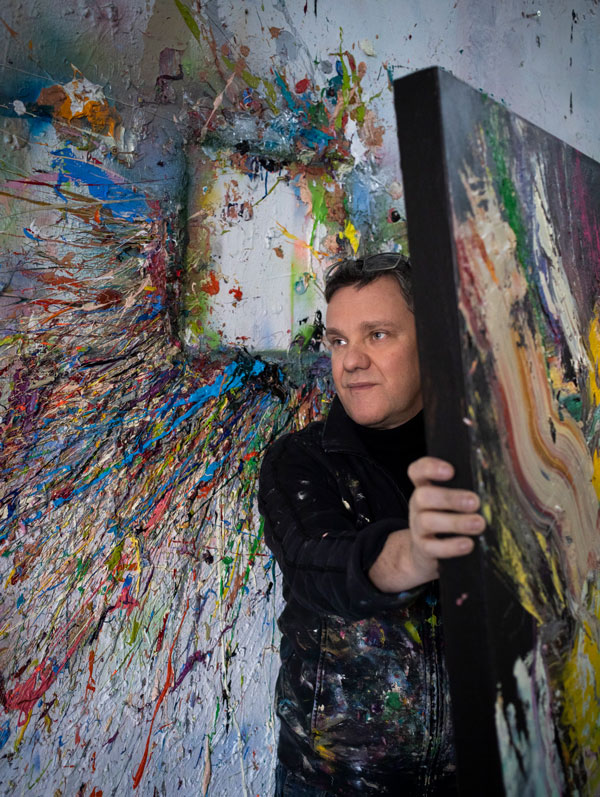Photo by Espen Eichhöfer – 2020

Figurative or abstract – Sebastian Heiner has yet to decide on an issue which has polarised art in the 20th century. Since the early 1990s, he has painted groups of highly abstract figures who communicate with one other with vehemence and sweeping gestures, figures from all imaginable social layers, in periods ranging from mythological times to the present, and from indeterminate regions of the world. Executed with powerful contrasts of colours, these figures disappeared a few years later to be replaced by symbolic and tachistic paintings in an intermediate realm composed of informal splashes of colour.
At the outset of the new millennium and under the influence of megacities in East and Southeast Asia, he developed a new kind of action painting in which broad and densely applied colours and structures spread out in rhythmic vibrations or positively explode outwards to the edges of the canvas. Somewhat later, in a series of pictures from Beijing and Shanghai, figures with faces and extended hands and feet, appeared in completely abstract universes of colour, expressing the turbulence of megalomaniacal civilisations. Eventually the veil of color retreated completely: dream-like figures, heroes and high priests, intertwined, cubist and elongated, standing or striding deliberately bearing radiant headdresses, penetrate an empty world, propelled forward by their own machine-like movements.
During his last visit to Shanghai, where he once again completed a series of action paintings, the artist drew robotic, vibrant water colour figures in his sketchbook. They walk or navigate in fantastic vehicles through urban landscapes entitled “Moloch City”. Heiner supplemented his sketches with short texts describing dream sequences in which the narrator penetrates unknown regions of foreign countries, hidden mazes within his own paintings or societies in a distant future, run by robots who have downgraded humanity to the status of insects.
Sebastian Heiner portrays two completely conflicting views of the world – abstract images expressing the noisy chaos of the big city, and figurative, in which futuristic mechanical beings, controlled by antennae, have taken control. The intermediate stages of production make clear, however, that these two visions do not exist in conflict, but rather appear alternately or, as in the case of a Berlin performance, begin figuratively only to dissolve into the abstract. The abstract series express the everyday chaos of the present, the figurative, a future to come, a dystopia in which man submits to the machine-world.
Following the water colour drawings, the artist produced a series of medium-sized and wall-sized paintings, featuring highly colourful robed figures with mosaic-patterned dresses, kimonos, harlequins and folkloric costumes with huge shoes. These figures dominate the canvas, marching, running and tumbling in different directions, seeking to assert their authority with hands raised high in a state of high excitement and/or desperation. Some act like humans, others, like robots controlled by their antennas and feelers, defending themselves with spines or carrying weapons and tools. Circular and grasshopper-like insects dominate the airspace. It is a dystopian world recalling Lang’s Metropolis or Orwell’s 1984, in which machines and psychological instruments of oppression have taken over.
The outlines of this brave new world fill the canvas, in similar manner to Heiner’s action paintings. The eruptive, zig zag patterned, crystalline mountains and spaces, are reminiscent of the work of utopian architects of the 1920s, such as Hablik, and the Taut and Luckhardt brothers. McCay’s dream-like journey to “Slumberland”, the ice palace of Jack Frost in “Little Nemo” also comes to mind. Heiner’s new pictorial universe is not just negative, but also includes utopian elements, signposting the crooked road to new fascinating adventures. The luminous colours, applied to small, mosaic-like surfaces, evokes the Fauve group of artists, their wildness and zest for life, while the consolidation of these shapes and colours into a definite structure recall Art Brut and folk art.
Sebastian Heiner’s latest figurative paintings are fantastical images of a new, chaotic world beyond paradise, but not without hope. Their various components, like his action paintings are not copied, nor predetermined, nor constructed, but rather drawn from his subconscious, nourished in turn by his study of diverse cultures and history and embellished by his imagination. The wall-filling formats, with titles added at a later date, resemble historical collages whose figures and symbols open up a myriad of future paths, but also warn of the uncertain future ahead.
Axel Feuß, March 2019


